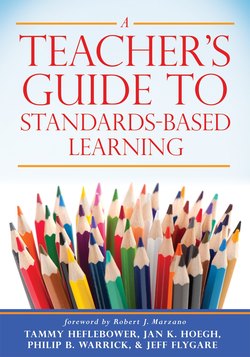Читать книгу A Teacher's Guide to Standards-Based Learning - Jan K. Hoegh - Страница 12
На сайте Литреса книга снята с продажи.
Оглавление| 2 | Instructing With Proficiency Scales |
Once teachers have created a strong unit plan around one or several priority standards, instruction can begin, again based around proficiency scales. The unit plan provides general guidance, but teachers now need to connect instructional strategies with the current level of student performance.
A teacher familiar with instructing in a traditional manner may find the instruction process this chapter describes rather foreign. In the sense that the central focus of instruction—the standard, rather than the content—is very different, this may be so. Teachers switching to standards-based learning may feel overwhelmed at first and unsure whether they will be able to make such a profound change to their instructional practice.
The reality is that once teachers change to standards-based instruction, they find that what they teach does not change very much. Even how they teach what they teach doesn’t change very much. But how the teacher thinks about what he or she teaches changes substantially. In working with veteran teachers who have made the shift to standards-based learning, we often hear them report that standards-based learning provides a clarity to what occurs in the classroom they had not seen before—a clarity they are eager to share with their students. Everything in the classroom, from planning to instruction to assessment and feedback, centers on student growth on the priority standards, and the conventional content is still there as the vehicle for that growth. After an initial transition period, most teachers discover a comfort level with standards-based learning, and even prefer it to traditional methods.
This chapter will discuss several sequential aspects of instruction with proficiency scales. First, it will introduce the pros and cons of preassessments, or benchmark assessments. Then, it will discuss how to introduce the proficiency scale to students, begin content instruction, assist students with developing proficiency, and move past proficiency.
Administering the Preassessment
An important first step is to identify where students reside on the proficiency scale at the start of instruction through the use of a preassessment. Although student performance will likely be poor since no instruction has taken place, both teacher and students must be aware of the starting point for learning. It is also likely that students will know some of the preassessment information, since students may have background knowledge from previous instruction earlier in the class, or from other classes. Knowing the starting point of each student, teachers can then guide students along the learning progression, with the goal of having every student achieve proficiency on the priority standards by the end of the learning period. Not all may get there, but it will certainly be the goal, one that teachers will continuously share with students.
Although we recommend preassessments at the start of instruction of each priority standard, there are pros and cons for the use of preassessments. The most important pros of preassessments include gaining clear understanding of the starting point of each student and understanding the background knowledge and abilities of the class as a whole. The cons consist primarily of the instructional time lost when giving these assessments and the effect that an initial low score may have on students. The lost instructional time is minimal and offset by a clear understanding of the direct needs of the students in starting the learning progress, which means the teacher can be much more efficient in designing learning experiences that immediately move students along that progression. If students are properly instructed in how to interpret low initial scores, they can be encouraged that the score will quickly change. Focusing less on the score and more on the future growth is key. Teachers might encourage students by saying, “It’s no problem that you are at a 1.0 score in the proficiency scale at the start, as long as we’re working on 2.0 and then 3.0!” Saying this often enough will create an atmosphere of growth in the classroom and focus students less on their current grade and more on the future.
